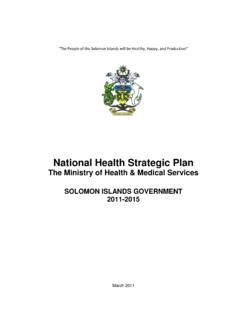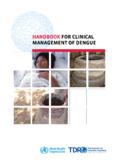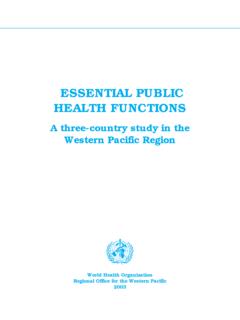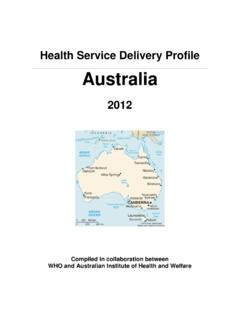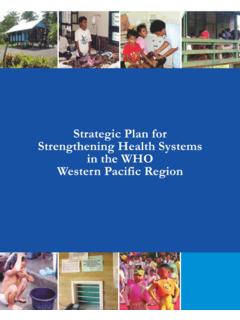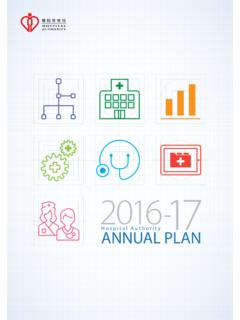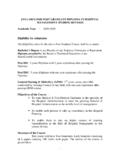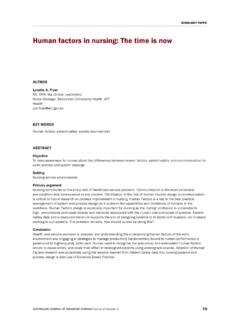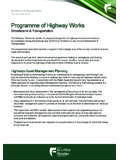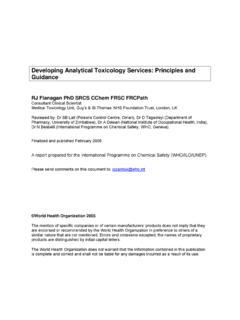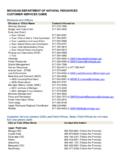Transcription of Fiji Health Service Delivery Profile-26Nov
1 Health Service Delivery profile fiji 2012 Compiled in collaboration between WHO and Ministry of Health , fiji Health Service Delivery profile , fiji , 2012 Page 1 of 12 fiji Health Service Delivery profile Demographics, social context and Health profile fiji is an island nation in the south-west Pacific Ocean, located between Vanuatu and Tonga. fiji 's Exclusive Economic Zone covers about million square kilometers of the Pacific Ocean with 330 islands, of which a third are inhabited. The total population was 837,271 in the 2007 census, 51% females, and 49% males, and 29 under the age of 15. The ethnic composition is diverse, with 57%, Indigenous Fijians (iTaukei), 37% Indo-Fijian population and 6% others (including other Pacific Islanders, Chinese and those of European descent)1. fiji has an increasingly urban population, with the Suva-Nasinu-Nausori corridor being the most heavily populated. This has been accompanied with an increase in urban unemployment2.
2 fiji experienced rapid growth after independence in the 1970 s, based on its sugar and tourism industries. However, a series of 4 coups, the first in 1987, has led to high levels of migration3 and static Gross domestic product (GDP). The Reserve Bank of fiji reported a per capita GDP of FJ$6,608 (at current prices) in 2011, with a GDP growth rate of (at constant prices)4. Infant and maternal mortality rates have been halved since the 1960s3. However, poor economic growth has contributed to fluctuating progress on key Health indicators, and an increase in rates of non-communicable disease. Selected development indicators are presented in Table 1. Table 1: Key development indicators in fiji Indicators Measure Year Comment/ notes Human development index 2011 Ranked 100, above average for countries in the medium human development group5. Literacy rate 93% 1996 Education is compulsory for school aged children6.
3 Total Health expenditure as a % of GDP. 2010 Population living under the poverty line 31% 2008-09 2008 09 Household Income and Expenditure Survey7 Life expectancy at birth 2011 Gradually increasing5. Infant mortality rate 2010 Infant and maternal mortality rates have been halved since the 1960s,3, but Currently fall short of the proposed fiji targets for the millennium development goals (MDGs)8. Under 5 mortality rate 2011 Maternal mortality rate 2010 Sources: UNDP 20115, Ministry of Health 201122, fiji Bureau of Statistics20107, fiji Bureau of Statistics1, Ministry of Health 201120 Health system strategies, objectives and legislation In light of this demographic and social context, the fiji Health system is attempting to cope with the triple burden of communicable disease, non-communicable disease and injuries30. fiji faces challenges in Health Service Delivery , with many public Health facilities in deteriorating condition and shortages of pharmaceutical and medical supplies a regular occurrence9.
4 To respond to this situation, the Ministry of Health developed a five year Strategic Plan 2011-2015. It aligns with the broader fiji government s Roadmap for Democracy and Sustainable Socio-economic Development 2009-2014, with the objectives that: Health Service Delivery profile , fiji , 2012 Page 2 of 12 communities are served by adequate primary and preventive Health services thereby protecting, promoting and supporting their well-being; and communities have access to effective, efficient and quality clinical Health care and rehabilitation services . The vision of the Ministry of Health is a healthy population driven by a caring Health care Delivery system , with a mission to provide a high quality Health care Delivery system by a caring and committed workforce working with strategic partners through good governance, appropriate technology and appropriate risk management facilitating a focus on patient safety and best Health status for the citizens of fiji .
5 Values of equity, responsiveness, and respect for human dignity; uphold the principle of universal coverage and equal access to Health services for all fiji citizens. The seven key outcomes of the Strategic Plan are: 1. Reduce the burden of Non-Communicable Diseases 2. Begin to reverse the spread of HIV/AIDS and preventing, controlling or eliminating other communicable diseases; 3. Improved family Health and reduced maternal morbidity and mortality; 4. Improved child Health and reduced child morbidity and mortality; 5. Improved adolescent Health and reduced adolescent morbidity and mortality; 6. Improved mental Health ; and 7. Improved environmental Health through safe water and sanitation. A number of government decrees and acts provide the regulatory framework for the Health system in fiji , including: Tobacco Control Decree 2010 Tobacco Control Regulation 2012 Food Safety Act 2003 Food Establishment Grading Regulations 2012 Radiation Health Decree 2009 Medical Imaging and Technologist Decree 2009 Quarantine Act (Cap.)
6 112) Medical and Dental Practitioners Decree 2010 Mental Health Decree 2010 National Ambulance Decree 2010 Child Welfare Decree 2010 Code of Marketing Control of Food for Infants and Children Nurses Decree 201110. Allied Health Practitioners Decree 2011 HIV/AIDS Decree 2010 Public Health Act (Cap. 111) Methylated Spirit Act (Cap. 113) Methylated Spirit Act (Cap. 225A) Medical Assistants Act ( ) Dangerous Drugs Act (Cap. 114) Pharmacy Profession Decree 2011 Medicinal Products Decree 2011 Optometrist Decree 2012 Burial and Cremation Act ( ) Animals (Control of Experiments) Act ( ) Private Hospitals Act (Cap. 256A) Public Hospitals & Dispensaries Act (Cap 110) A review of the Public Health Act was planned for 201213. The 2011 Corporate Plan states intention to establish a Health Policy Commission13 to align Service Delivery with this myriad of regulations. An Optometrist Decree is currently being formulated for approval by Cabinet.
7 Health Service Delivery profile , fiji , 2012 Page 3 of 12 Service Delivery Model and Provider Network Health services in fiji are tax funded, provided manly at public facilities and primarily free of charge. The Ministry of Health and Service management are broadly speaking, are divided into curative, and public Health and preventative (see Table 2). Under the umbrella of public Health services , the Ministry of Health operates via a system of four decentralised divisional offices, geographically based: Central and Eastern (often combined) in Suva, Western in Lautoka, and Northern in Labasa (Map 1). The divisional offices are responsible for provision of public Health services , operation of the sub-divisional hospitals, Health centres and nursing stations, and are led by a Divisional Medical Officer, reporting to the Deputy Secretary Public Health . Also reporting to the Deputy Secretary Public Health is a number of national advisors for specific public Health areas, including: family Health , non-communicable diseases, Health promotion, communicable diseases, food & nutrition, environmental Health and oral Health .
8 Curative services are led by a Deputy Secretary of Hospital services . fiji offers a range of specialised services , supported by overseas medical treatment teams. Across fiji s divisional and specialist hospitals there are approximately 1185 inpatient beds available. This equates to a ratio of beds per 1000 population8. A National Clinical Service Planning Framework was first developed in 2005, and reviewed in 2009. Following this, Clinical services Networks were established in 2010 to facilitate clinical quality improvement by linking clinical services and strengthen the communication with divisional public Health offices which is vital to improve services in areas such as maternal and child Health , mental Health and NCDs11. A revised Clinical services Plan for 2010-2014 was also developed and implemented with ten objectives12. There are also various statutory bodies, councils and committees (such as the National Blood Service , National Food & Nutrition Centre, the National Health Promotion Council, and the National Diabetic Service ) that provide supportive roles in the management and administration of specific Health services .
9 This Service Delivery organisational structure, essential services , performance targets and planned capital works are documented annually in a corporate plan13 and reported upon in an annual report. Table 2: Levels and types of Health services provided in fiji , 2012 Level of Service Type of Service Village Health workers Volunteers, from the community or villages; trained for six weeks to provide basic first aid and treatment. Communities financially support their village Health workers, while the Ministry of Health provides training, pharmaceuticals and equipment8. Nursing Stations Staffed by a single nurse who conducts outreach visits into communities within a designated nursing area. services provided include: population Health monitoring, maternal/child clinics, general outpatients, school Health , family Health , reproductive Health and domiciliary services . Health Centres Staffed by a medical officer or nurse practitioner in addition to nurses. They are the first level of referral from a nursing station.
10 services provided include: 24 hours on-call services , population Health monitoring, maternal/child clinics, general and special outpatients, school Health , family Health , reproductive Health and domiciliary services . Health centres vary in services based on the size of the population it services . Larger urban Health centres have a pharmacy, laboratory, radiology unit, dental unit, environmental Health officers, dieticians and nurses who conduct school visits8. Sub-divisional hospitals Staffed with general practitioners, midwives and registered nurses. They provide a range of primary Health and acute care, including: accident & emergency services , general inpatient care, routine obstetrics, dental services , limited diagnostic services (laboratory and radiology) and facilitate the provision of outreach services to the nursing stations within the sub-division. Health Service Delivery profile , fiji , 2012 Page 4 of 12 Level of Service Type of Service Divisional hospitals Colonial War Memorial Hospital based in Suva in the Central Division, Lautoka Hospital in the Western Division and Labasa Hospital in the Northern Division.


